Types Of Eupatorium: Tips For Distinguishing Eupatorium Plants


Eupatorium is a family of herbaceous, blooming perennials belonging to the Aster family.
Distinguishing Eupatorium plants can be confusing, as many plants formerly included in the genus have been moved to other genera. For instance, Ageratina (snakeroot), a genus that now contains more than 300 species, was formerly classified as Eupatorium. Joe Pye weeds, previously known as types of Eupatorium, are now classified as Eutrochium, a related genus containing about 42 species.
Today, most plants classified as types of Eupatorium are commonly known as bonesets or thoroughworts-- although you may still find some labeled as Joe Pye weed. Read on to learn more about distinguishing Eupatorium plants.
Differences Between Eupatorium Plants
Common boneset and thoroughwort (Eupatorium spp.) are wetland plants native to the eastern half of Canada and the United States, growing as far west as Manitoba and Texas. Most species of bonesets and thoroughworts tolerate cold as far north as USDA plant hardiness zone 3.
The primary distinguishing characteristic for boneset and thoroughwort is the way the fuzzy, erect, cane-like stems seem to perforate, or clasp, the large leaves which may be 4 to 8 inches (10-20 cm.) long. This unusual leaf attachment makes it easy to tell the difference between Eupatorium and other types of flowering plants. The leaves are lance shaped with finely toothed edges and prominent veins.
Boneset and thoroughwort plants bloom from midsummer through fall producing dense, flat-topped or dome-shaped clusters of 7 to 11 florets. The tiny, star shaped florets may be dull white, lavender, or pale purple. Depending on the species, bonesets and thoroughworts can reach heights of 2 to 5 feet (61 cm. to 1.5 m.).
Gardening tips, videos, info and more delivered right to your inbox!
Sign up for the Gardening Know How newsletter today and receive a free copy of our e-book "How to Grow Delicious Tomatoes".
All species of Eupatorium provide important food for native bees and certain types of butterflies. They are often grown as ornamental plants. Although Eupatorium has been used medicinally, it should be used with great care, as the plant is poisonous to humans, horses, and other livestock that graze the plants.

A Credentialed Garden Writer, Mary H. Dyer was with Gardening Know How in the very beginning, publishing articles as early as 2007.
-
 Get Ready For A Summer Of Hummers! Grow These Full Sun Hummingbird Plants and Flowers
Get Ready For A Summer Of Hummers! Grow These Full Sun Hummingbird Plants and FlowersIf you’re lucky enough to enjoy a sunny backyard, make sure you are maxing out on your pollinator opportunities and grow these full sun hummingbird plants and flowers
By Tonya Barnett
-
 12 Lush Alternatives To A Lawn For Sustainable Spaces
12 Lush Alternatives To A Lawn For Sustainable SpacesAlternatives to a lawn are beautiful and also beneficial to your local ecosystem and its pollinators. Explore our top picks for plants to replace grass.
By Tonya Barnett
-
 Controlling Joe-Pye Weeds: How To Remove Joe-Pye Weed
Controlling Joe-Pye Weeds: How To Remove Joe-Pye WeedWhile many people enjoy this attractive looking plant, some gardeners would prefer to remove Joe-pye weed. If you are one of them, this article has tips for getting rid of joe-pye weed in your garden.
By Susan Patterson
-
 Joe-Pye Weed Care - Growing Joe-Pye Weed Flowers And When To Plant Joe-Pye Weed
Joe-Pye Weed Care - Growing Joe-Pye Weed Flowers And When To Plant Joe-Pye WeedJoe-pye weed is far from an unwanted weed to me. This attractive plant produces pale pink-purple flowers that last from mid-summer through fall. It?s a great addition to the garden, and this article will help with that.
By Nikki Tilley